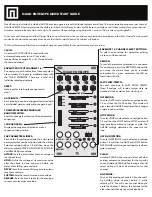
8
RAISING AND LOWERING THE SIDE-RAILS
PLEASE NOTE:
•
For occupant safety, always ‘
lift and lock
’ (
raise
) the side-rails at the head-end first, and always
lower
the side-rails at the foot-end first.
•
To avoid damage and occupant distress, NEVER let go of the rails and allow them to drop.
To raise the side-rails:
Hold the upper side-rail at the head-end and slide up the channel until the
locating pin engages with a click. Repeat at the foot-end.
To lower the side-rails:
Hold the upper side-rail at the foot-
end and lift slightly to ‘unlock’ the
release button on the side of the foot board. Press and hold the release
button and gently lower the side-rails until they rest on the stop at the
bottom of the track. Repeat at the head-end.
WARNING
If the bed has timber side-rails, safety cut-out buttons situated on the
chassis prevent possible injury or damage if an attempt is made to rotate
the mattress support to the chair position while the side-rails are in the
raised position. Unless both sets of side-rails are fully lowered to depress
the cut-out buttons the bed will not rotate to chair position. If there is an
audible ‘beep’ and the bed will not move when pressing the Stand ‘In’ or
‘Out’ buttons on the hand control check that the
side-rails are lowered and
resting on the buttons.
Side-rail
release button
Safety cut-
out button
GUIDANCE ON SAFE WORKING LOADS
SECTION FIVE:
MAINTENANCE & TECHNICAL INFORMATION
PLEASE NOTE:
The Safe Working Load (left) must not be confused
with the Maximum User Weight (right).
In common with other manufacturers, we quote a Safe Working Load (SWL) for each of our beds
(please see Technical Data section). When a bed is tested to derive the safe working load, a static
load is evenly distributed over the whole surface of the product. Remember that when a bed is in
use, the load is rarely static or evenly distributed. Should a visitor sit down heavily on one side of
the bed, the shock load at that point will be extreme, the load will be uneven and the total
combined weight may exceed the Safe Working Load of the bed.
The Safe Working Load must take account not only of the weight of the user, but also of the
mattress, bed linen, and other items loaded onto the bed (e.g. a pump for an air-driven mattress)
during daily use. It is also important to consider any likely future weight gain by the bed user.
Typically:
•
A mattress might weight 20kg
•
An air-driven system could weigh as much as 30kg
•
Two pillows weigh approximately 3kg
•
Bed linen can weigh roughly 12kg
PLEASE NOTE:
The total weight of such items, together
with anything else placed on the bed, PLUS
the weight of the user must NEVER exceed
the stated Safe Working Load for the bed.
NEITHER NEXUS DMS LTD, NOR ANY OF ITS EMPLOYEES, CAN ACCEPT RESPONSIBILITY FOR ANY
ISSUES ARISING FROM OVERLOADING A BED. SHOULD DAMAGE RESULT FROM SUCH ACTIONS,
ANY REPAIRS NECESSARY WILL NOT BE COVERED UNDER WARRANTY.
Summary of Contents for Rota-pro CB3RP-210-90
Page 11: ......






























